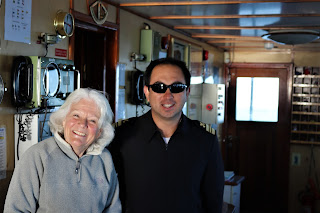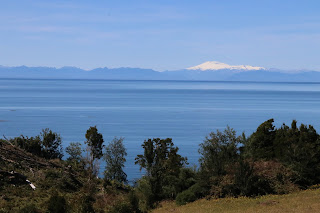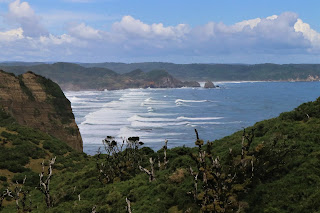When
we left Chiloe on Wednesday 14th March we thought the weather would
improve. It didn’t.
We
spent the next couple of days at Puerto Varas, a very nice town on the southern
shores of an immense lake, Lago Llanquihue, with views across to Volcan Osorno
(although we never saw it). On Thursday gale force winds whipped the trees
around and turned the lake into a raging sea so kayaking was out and on Friday
the gods opened the taps, so birdwatching was out and so was any chance of
seeing the apparently spectacular volcano.
That
being the case we decided to get on the road again and drive in an
anti-clockwise direction around the lake towards some waterfalls, hopeful that
it might stop raining at some stage .
We
arrived at the Saltos Petrohue where there was a series of impressive rapids
and waterfalls created by a huge downfall of volcanic stuff which had caused a
log jam on the river between two lakes. However, getting to the waterfalls
involved walking along a trail and, guess what, it was p…..g it down with rain.
We
then drove further up the road and found a very pleasant restaurant to have
lunch and dry out and it continued to rain.
A
little further along the road there was a very loud noise which turned out to
be coming from a smoking tyre and the tyre was undeniably flat and still it was
p…..g it down with rain. So, the next
job was to change the wheel and Alan spent the best part of the next hour doing
so, much of the time lying down in an ever deepening puddle because, let’s not
forget, it was p…...g it down with rain.
Don’t let anyone tell you that travelling is all fun.
Meanwhile
Sue was for once doing as asked which was to please stay in the vehicle and
think of England. This she did but she
later admitted that she didn’t think very much about England as about how nice
and dry she was and how horrible and soggy wet Alan was.
Said
soggy wet person then got back into the truck and we continued on our way to
the town of Osorno where we found a decent B & B. By the way, it was still raining when we
turned in for the night.
Saturday
was a much better day. We managed to get
two new tyres fitted, the B & B washed all Alan’s wet and muddy clothes,
the sun came out and we took advantage of the improved weather to go and visit
yet more waterfalls in the Puyehue national park some fifty miles away.
Puyehue National Park
Walking in Puyehue National Park
Waterfall, Puyehue National Park
Tree ferns in the national park
This
being the Chilean Lake District we set off on Sunday in a northerly direction
to another lake, Lago Villarrica, with yet another volcano sitting behind it.
There
were lots of agencies advertising all sorts of outdoor activities in the area and
Alan, who was feeling the lack of an adrenalin-rush, arranged to do what they
call Hydro Speeding. This is basically where they give you a large polystyrene
body board and chuck you into a set of rapids for an hour. He turned up at the appointed time only to be
told that because he was the only one who wanted to do it they weren’t
going. Just as well, what on earth was
he thinking off at his age?
He
settled instead for something gentler and so we went to have a look at the
Volcan Villarrica which was everything that a volcano should be. We drove to the foot of the volcano and it
loomed out of the surrounding forest in the classic volcanic manner with its
pyramidal cone half covered in snow and with an ominous wisp of sulphur smoke
coming out of the top.
As we got closer we could see the route that the molten lava had taken during the last eruption which was in 2015. Much of the time we were walking over fine black volcanic ash, but it was surprising just how readily plants had colonised this apparently inhospitable growing medium and started to flourish.
Having seen all we wanted to of Villarrica, we headed off to the city of Temuco where we arrived on Thursday afternoon. We normally try to avoid cities, but Temuco is apparently a city with a strong Mapuche heritage and we thought it worth a visit.
The
Mapuche are the largest indigenous group in southern South America and their
name means ‘the people’s land’ taken from the words ‘mapu’ (land) and ‘che'
(people). They were never subdued by the
Incas and successfully resisted the Spanish for over two hundred years. Nevertheless, their original homeland has
been reduced from over 100,000 square kilometres to just 5,000, most of this in
the area between Temuco and the Pacific coast.
Temuco
is a city much like any other city although there are undercurrents of discord
between the large Mapuche population, who consider themselves dispossessed, and
the police. We noticed that there was some difficulty close to the Plaza de
Armas where there were riot vehicles parked apparently in readiness for some
form of confrontation although we never saw the confrontation if indeed there
was one. There were however a lot of carabineros around including female
carabineras with very tight fitting hats and determined expressions, oh and
pistols.
In the
main square there was a bronze depicting various figures from the city’s past
including a conquistador that had been graffiti covered, a soldier with a rifle
who had been graffiti covered and a Mapuche warrior who was scrupulously not
covered in graffiti. We mentioned this
to Martin, the son of the hostel owner where we were staying, who confirmed
that this was one of the manifestations of anger that the Mapuche people feel
for the expropriation of their lands.
We
much enjoyed visiting the very large and colourful outdoor market which was
full of mounds of fruit and vegetables, herbs and spices, meat, fish, flowers, wooden
implements and leather goods. The stall holders were lively and friendly and
some of them were very happy to be photographed. There were sacks full of
spices, smoked chilli, paprika, red hot chilli, not so red hot chilli, chilli
with herbs and we bought three bags, Alan having sampled them all and nearly
burnt out the roof of his mouth in the process.
Wooden sculpture of Mapuche Warrior - wonderful expression of sadness mingled with noble resignation
Ox cart outside Temuco market
Leading the oxen
Stall holder selling Pinones (Aracuaria tree nuts)
Market stall
Spices for sale
Stall holders selling spices
On Thursday 22nd March we left Temuco (in the pouring rain) and drove West to the small town of Puerto Saavedra on the Pacific coast where it was still pouring with rain for much of the time. In between rain storms we went to have a look at the ocean. It did not disappoint. The combers came crashing in with spindrift whizzing off the tops of the waves as they charged shoreside and pounded on the black sandy beach.
However, the high point of our stay was when we drove south of the town through some remote countryside and isolated Mapuche communities to Lago Budi, the only inland saltwater lake in Chile and apparently visited by over 130 species of water bird. We saw upwards of two hundred black neck swans, also some white tufted grebes, quite a lot of ducks and some egrets but the swans en masse took the prize.
When the sun finally came out we opened the tent up and found that everything was soaking wet which did not make either of us particularly happy. We took the mattress and the duvet and the sheet out and first of all laid them out in the sun and then next to the stove in our cabana. Mercifully, everything was dry by next morning.
The
next morning, Saturday, we left Puerto Saavedra, got on a little cable ferry
that took us across the mouth of the river, and then continued our merry way
north along the Pacific coast.
To our delight we found the most wonderful wild camping site on a rocky outcrop overlooking the Pacific. We reached it by driving up a very steep and very rocky track which had not been recently navigated by anybody else as far as we could see, and then by means of asking Lucy to do some acrobatics in the way of leaping over a bit of a ski jump with a boulder strewn area beyond. However, all was well, we deployed the tent and Alan got a very creditable camp fire going and the Carabineros didn’t come along and spoil this one.
It was
a very cold night but we were tucked up in our warm and thankfully dry
tent. It was still exceedingly cold the
next morning, but we were rewarded by the bay itself in full sunshine and low
mist hurrying across the dunes and out to sea to meet the advancing phalanxes
of Pacific combers coming in to the land.
Shortly after, the sun came over the mountain top to the east and first
of all touched the top of the rocky outcrop where we were camped and then moved
down to illuminate the tent and the vehicle, and we could feel our fingers once
more.
Having
packed the tent up we had the interesting exercise of getting Lucy down from
her perch. This involved reversing over
the boulder strewn area and then down a slope of about 45 degrees without
turning Lucy over. This was achieved
without incident.
Interesting access to campsite
After
that little bit of excitement we had a very boring day on busy main roads in
order to circumnavigate Concepcion which is Chile’s second largest city and we ultimately
found ourselves in Florida. In case you
are wondering, we hadn’t taken a plane and flown a few thousand miles north,
it’s actually the name of a small town in the central valley of Chile.
Roadside lilies
Monday
was an interesting day. The first part of the day was okay, we packed up from
our cabana and travelled back to the Pacific coast. Then we came to a place
which had a wide black sandy bay and Alan said “Oh, this is lovely, let’s go
out on there and find somewhere marvellous to camp”. What a stupid idea!
It was
a wide sandy bay and plenty of vehicles had been across it, BUT they were
lighter vehicles than Lucy who weighs in at a canny three tons. Alan let plenty of air out of the tyres but
the sand was very soft and after about half an hour he had to admit that we had
dug ourselves rather a deep hole from which it was not going to be possible to
extract ourselves unaided.
We
found a guy in a red pickup and having flagged him down he said that he was
indeed happy to help. He therefore took
us back to where Lucy was woefully up to the axles in deep sand and after
digging out some sand we hitched Lucy up to his Nissan and he pulled us out
until we were on slightly firmer sand. The ignominy of it, a Land Rover having to be rescued by a Nissan! He will probably
be dining out on that story for a while to come but we were very grateful all
the same.
We are
now in the town of Santa Cruz which is in the heart of the wine growing
area. It is an unremarkable place and we
are only here to catch up on the usual domestic tasks and admin. Thankfully, we seem to have left the cold and
rain behind us, at least for the time being, and we are enjoying the hot sunny
days.
From
here we plan to step up the pace as we continue north to Santiago and then
across the Andes into Argentina.















































































